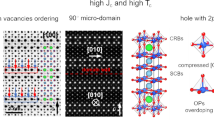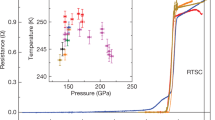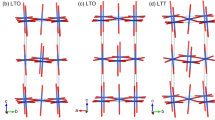Abstract
Materials within the phase diagram Y2O3–BaO–CuO have recently generated great interest because of the observation of superconductivity with a critical temperature (Tc ) of ≳90 K1,2; the current consensus is that YBa2Cu3O7−x (x ≈ 0.2) is the superconducting phase (see, for example ref. 3). Hazen et al.4 concluded, from a single-crystal X-ray diffraction experiment, that its structure is based on the corner-linked octahedral perovskite structure: the tetragonal unit cell (space group P&4bar;m2) arises from a tripling of the c-axis resulting from the ordering of yttrium and barium cations and associated oxygen defects. Here we present high-resolution neutron powder diffraction data for this phase with x = 0.15(7). Our results agree with ref. 4 with respect to cation positions, but the location of one set of oxygen defects is substantially different and necessitates the lowering of lattice symmetry from tetragonal to orthorhombic (space group Pmmm), in agreement with separate findings5–8. In contrast to the 35-K superconductor, La1.85Ba0.15CuO4, the corner-linked CuO4 planar groups are connected not only as sheets in the a–b plane but also as chains parallel to the ft-axis. The average copper valence is 2.23 (5). From bond valence arguments we infer that the Cu2+ and Cu3+ ions preferentially occupy square pyramidal and square planar sites respectively. Crystal chemical considerations suggest that these structural features may be involved in the superconducting mechanism.
This is a preview of subscription content, access via your institution
Access options
Subscribe to this journal
Receive 51 print issues and online access
$199.00 per year
only $3.90 per issue
Buy this article
- Purchase on Springer Link
- Instant access to full article PDF
Prices may be subject to local taxes which are calculated during checkout
Similar content being viewed by others
References
1. Wu, M. K. et al. Phys. Rev. Lett. 58, 908–911 (1987). 2. Hinks, D. G. et al. Appl. Phys. Lett, (in the press). 3. Rao, C. N. R., Ganguly, P., Raychaudhuri, A. K., Mohan Ram, R. A. & Sreedhar, K. Nature 326, 856–857 (1987). 4. Hazen, R. M. et al. Phys. Rev. Lett, (in the press). 5. Beno, M. A. et al. Appl. Phys. Lett, (in the press). 6. Greedan, J. E., O'Reilly, A. & Strager, C. V. Phys. Rev. (submitted). 7. Capponi, J. J. et al. Europhys. Lett. 3, 301–308 (1987). 8. Beech, F., Miraglia, S., Santoro, A. & Roth, R. S. Phys. Rev. Lett, (submitted). 9. Johnson, M. W. & David, W. I. F. Rutherford Appleton Lab. Rep. No. 85/112 (1985). 10. Matthewman, J. C., Thompson, P. & Brown, P. J. J. appl. Crystallogr. 15, 167–173 (1982). 11. Hestermann, K. & Hoppe, R. Z anorg. allg. Chem. 367, 249–253 (1969). 12. Brown, I. D. & Wu, K. K. Acta crystallogr. B32, 1957–1959 (1976). 13. Tindemans, J. C. M. & Verschoor, G. C. Mater. Res. Bull. 9, 1947–1952 (1974).
Author information
Authors and Affiliations
Rights and permissions
About this article
Cite this article
David, W., Harrison, W., Gunn, J. et al. Structure and crystal chemistry of the high-Tc superconductor YBa2Cu3O7−x. Nature 327, 310–312 (1987). https://doi.org/10.1038/327310a0
Received:
Accepted:
Issue Date:
DOI: https://doi.org/10.1038/327310a0
This article is cited by
-
Experimental and theoretical approaches on magnetoresistivity of Lu-Doped Y-123 superconducting ceramics
Journal of Materials Science: Materials in Electronics (2013)
-
Structure and Charge-Transfer Mechanism in Y1−x Ca x Ba2Cu3O7−δ Through Direct Doping
Journal of Superconductivity and Novel Magnetism (2012)
-
A structural study of chemical stability of (Y1?x Ca x)(Ba2?x La x )Cu3O7??(x= 0.0, 0.2, and 0.4)
Journal of Superconductivity (1996)
-
Thermal analysis of Y1−xCaxBa2Cu3O7−y
Journal of Thermal Analysis (1994)
-
The role of Y/Ba on the formation of high-Tc superconducting phase in Y-based system
Journal of Superconductivity (1993)
Comments
By submitting a comment you agree to abide by our Terms and Community Guidelines. If you find something abusive or that does not comply with our terms or guidelines please flag it as inappropriate.



